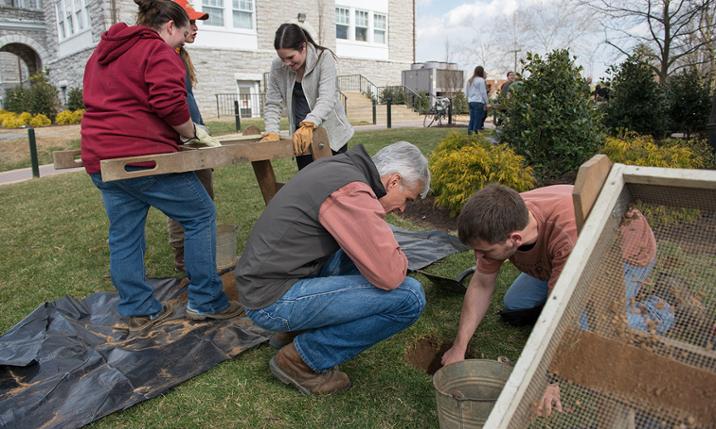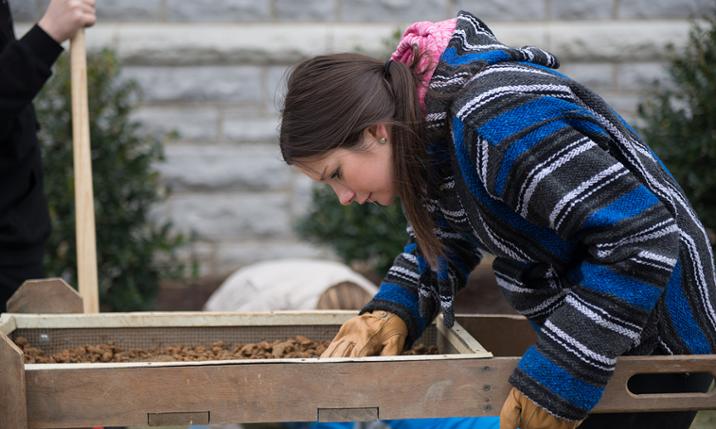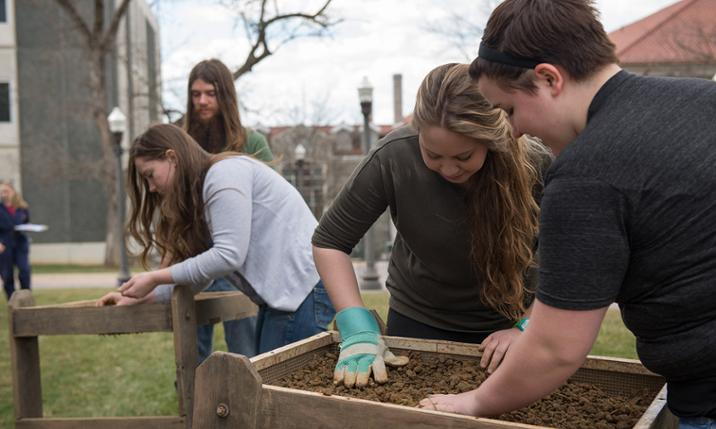Dig this -- Archaeology students excavate on campus
News
Letting the evidence speak
A group of James Madison University students are seeking to uncover some of the history and stories hidden beneath the university’s 106-year-old campus.
The historical archaeology students, under the direction of Dr. Dennis Blanton, an archaeologist and assistant professor of anthropology at JMU, are initially focusing their work on the changes in landscaping on the “Quad” over time and the area around Moody Hall, which rests on the site of a post-Civil War farmhouse that belonged to the original landowners, the Henry D. Newman family.
Other searches will focus on the wooded area near the Edith J. Carrier Arboretum, a portion of which borders the site where Confederate Brig. Gen. Turner Ashby was killed during a skirmish with Union troops on June 6, 1862, as well as telltale evidence of the cultural revolution on campus in the 1960s and 1970s.
“I have every reason to believe that we’ll find evidence of some of these things in the soil,” Blanton said. “It’s a brand of detective work. The evidence will speak for itself.”

Unbiased history
The project required a lengthy approval process before the fieldwork could begin. Blanton met with JMU administrators as well as representatives from Facilities Management and local utility companies to ensure that the digging will not damage underground lines or alter campus aesthetics. “We’re taking a respectful approach,” Blanton said. “This is a privilege. We’ve been granted an opportunity to excavate areas that people don’t normally dig in.”
The students are currently conducting shovel tests at each site, which involve cutting a circle of sod about the diameter of a dinner plate and digging a few feet down into the soil. At regular intervals, a shovel full of dirt is poured into a box screen, where it is sifted to allow the lighter soil to fall through the screen mesh while the heavier pieces remain inside the box. Any items of possible historical value are documented for testing, and the soil and the sod are replaced. As the project evolves, the test sites could be extended to allow for more significant discoveries.
On a recent dig, a team working outside Moody Hall uncovered a brick believed to have been part of the Newman farmhouse. The find sent a charge through the group, which was excited to be finally excavating after months of research and numerous weather delays.
“As archaeologist David Hurst Thomas so aptly says, 'It’s not what you find; it’s what you find out,” said Aaron Lovejoy, a junior anthropology major from Yorktown, Va. “History is always written with a certain bias. The cool thing about archaeology is that what’s in the ground is unbiased. It’s a clean slate of interpretation. And historical archaeology gives you a chance to listen to the voices of people who weren’t written about.”

Hands-on for everyone
Catherine Grimes, a freshman from Chesterfield, Va., said the work is focused and collaborative. “We’re all pretty much interested in the same thing, whether it be the historical side or the anthropological side of it,” she said. “We all contribute. One person will dig, another screens and another records. It turns what can be a monotonous task at times into something that’s fun.”
Previously, the class’ fieldwork involved trips up to an hour away, but Blanton, who arrived at JMU in the fall of 2013, wanted the students to gain experience at sites that were more localized and sustainable. “Why not tell the story of our own property?” he asks.
Similar work has been done on college campuses in the U.S., including Brown University, where Blanton completed his master’s degree, and the College of William and Mary, where he directed the Center for Archaeological Research from 1989 to 2005. The mother of all campus archaeology projects is Harvard Yard, which has been going on for more than 20 years.
“At the end of the day, we’re giving our students of archaeology a quality experience,” Blanton said. “The only guarantee is that they’ll learn something.”
###
Jim Heffernan (’96), JMU Public Affairs

